
PREV ARTICLE
NEXT ARTICLE
FULL ISSUE
PREV FULL ISSUE
MORE ON THE COLONIAL COUNTERSTAMP MYSTERY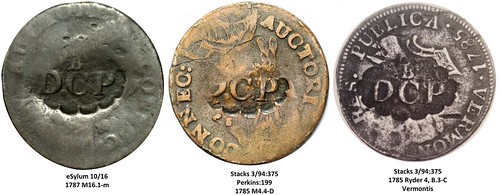 Randy Clark writes: Robert Martin and I were discussing the Connecticut copper with a B / D.CP counterstamp shown in the October 2, 2016 issue of The E-Sylum. We agree on an attribution of 1787 Connecticut copper variety M16.1-m for the image submitted by Bill Groom. Robert also recalled two other similar pieces illustrated in the Stacks March 1994 Sale. A 1785 Vermont Ryder 4 cataloged as lot 375, illustrated on page 37 (image attached) and a 1785 Connecticut M4.4-D cataloged as lot 105, illustrated on page 16. This latter piece was also auctioned off in the Stacks Perkins sale of January 2000 as lot 199. Unfortunately, Robert and I do not have any information on the counterstamp itself, other than what is viewable in these images. Hopefully one of The E-Sylum's other readers can provide more insight. We hope this information is useful to help with the Colonial Counterstamp Mystery. Thanks. At top is a composite image created by Randy showing Bill Groom's piece alongside similar counterstamps from two earlier
Stack's sales. Below are his composite images of the complete coins as illustrated in the catalogs. Click on any of the images to see larger
versions in our Flickr archive. -Editor
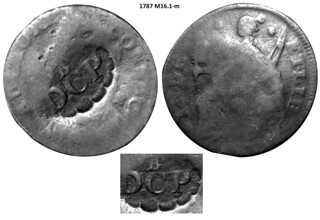 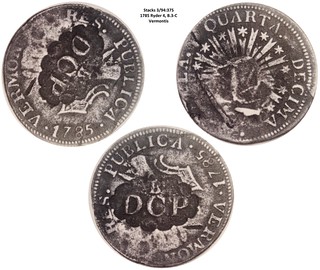 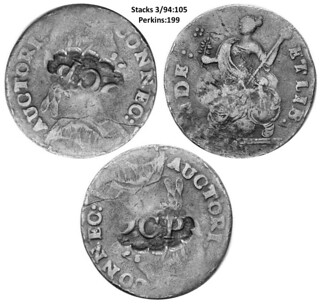 Syd Martin writes: I cannot provide concrete answers, but I have the identical counterstamp on a 1785 Vermont landscape, attached. Ex Stack’s, 13Jan09, Lot 7216; earlier Stack’s, March 1994, Lot 375). This may support a New England origination. 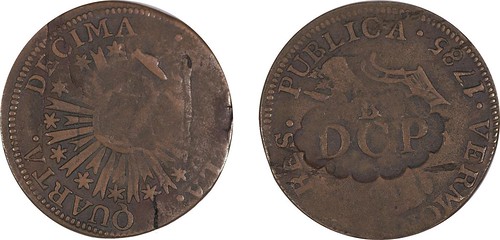 Small world. Great home for a nice coin. The black and white catalog photo didn't do it justice. This is an attractive piece.
-Editor
Roger Burdette writes: My suggestion for DCP. D = abbreviation for "penny", from the Roman denarius. Similarity of script of D and P propose a link in meaning, and repetition of the amount from the L/S/D system is reasonable given the circumstances. Using "D" to represent Dutch does not work; however, there might be a connection via the Dutch denomination "duit" roughly equivalent to an English "penny." If correct this implies a multinational congregation, but is difficult to reconcile with colonial religious practices of the 18th century. Thanks, everyone. This stamp is clearly not one of a kind, and was in use around the late 1700s. The Connecticut and Vermont
undertypes do suggest a New England circulation. I also thought of "d" as a likely abbreviation for penny, although any interpretation of
the lettering is speculative without other evidence. Still, "Church Penny" is an attractive interpretation for "CP".
Here's where some detective work is in order. A review of New England church histories for the period may well turn up an account of coins being overstamped for use as church pennies. The "B" could well mean "Boston", so that wouldn't be a bad place to start. Digitization may make this search easier than ever, but there's never a shortcut to good numismatic research. -Editor To read the earlier E-Sylum article, see: Wayne Homren, Editor The Numismatic Bibliomania Society is a non-profit organization promoting numismatic literature. See our web site at coinbooks.org. To submit items for publication in The E-Sylum, write to the Editor at this address: whomren@gmail.com To subscribe go to: https://my.binhost.com/lists/listinfo/esylum All Rights Reserved. NBS Home Page Contact the NBS webmaster 
|